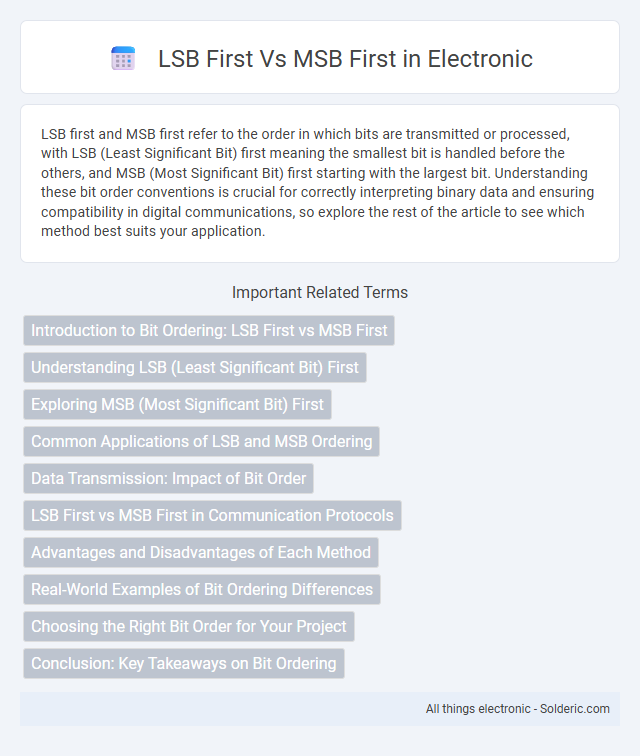LSB first and MSB first refer to the order in which bits are transmitted or processed, with LSB (Least Significant Bit) first meaning the smallest bit is handled before the others, and MSB (Most Significant Bit) first starting with the largest bit. Understanding these bit order conventions is crucial for correctly interpreting binary data and ensuring compatibility in digital communications, so explore the rest of the article to see which method best suits your application.
Comparison Table
| Aspect | LSB First (Least Significant Bit First) | MSB First (Most Significant Bit First) |
|---|---|---|
| Definition | Transmits or processes bits starting from the least significant bit. | Transmits or processes bits starting from the most significant bit. |
| Bit Order | Right-to-left (bit 0 to bit n) | Left-to-right (bit n to bit 0) |
| Common Uses | Microcontroller communication (e.g., SPI), some serial protocols. | Networking protocols, file formats, most human-readable binary data. |
| Data Interpretation | Easier for incremental arithmetic and binary counting. | Matches natural reading order and number representation. |
| Example | Binary 1101 transmitted as 1-0-1-1 (bit 0 first) | Binary 1101 transmitted as 1-1-0-1 (bit 3 first) |
| Compatibility | Preferred in devices prioritizing hardware simplicity. | Favored in protocols requiring standardization and clarity. |
Introduction to Bit Ordering: LSB First vs MSB First
Bit ordering defines how binary data is transmitted or processed, with LSB first meaning the least significant bit is handled before others, and MSB first indicating the most significant bit comes first. Choosing between LSB first and MSB first impacts data interpretation in communication protocols, file formats, and memory storage. Understanding your system's bit order ensures accurate encoding and decoding of binary information.
Understanding LSB (Least Significant Bit) First
LSB (Least Significant Bit) first refers to the binary data transmission or storage method where the bit with the lowest value (rightmost bit) is processed or transmitted before higher-value bits. Understanding LSB first is crucial for interpreting binary communication protocols, data serialization, or memory layouts, since it affects how multi-bit values are reconstructed or displayed. Your ability to distinguish between LSB first and MSB first formats ensures accurate data processing in computing systems and embedded applications.
Exploring MSB (Most Significant Bit) First
MSB first transmission prioritizes sending the most significant bit before others, ensuring critical data is processed earliest. This bit order is crucial in applications like digital communication and data encoding, where timing and priority impact performance. Understanding MSB first can optimize your system's data interpretation and improve error detection accuracy.
Common Applications of LSB and MSB Ordering
LSB first ordering is commonly used in applications such as serial communication protocols like SPI and I2C, where data transmission starts with the least significant bit to simplify hardware design. MSB first ordering is prevalent in networking protocols like Ethernet and data encoding standards such as ASCII, ensuring that the most significant bit is transmitted first for consistency and compatibility. Understanding your system's requirements helps determine whether LSB or MSB first ordering optimizes data processing and communication efficiency.
Data Transmission: Impact of Bit Order
Data transmission efficiency and accuracy are significantly influenced by whether the bit order is Least Significant Bit (LSB) first or Most Significant Bit (MSB) first. Choosing LSB first means the transmission starts with the bit representing the smallest value, which is crucial for protocols that prioritize time-sensitive or incremental data processing. MSB first transmission sends the highest value bit initially, often used in systems requiring immediate recognition of data magnitude for quicker decision-making.
LSB First vs MSB First in Communication Protocols
LSB first and MSB first define the bit order in communication protocols, determining whether the least significant bit or the most significant bit is transmitted first. Choosing the correct bit order ensures accurate data interpretation between devices, as mismatched bit orders can lead to communication errors. Understanding your communication protocol's bit order is crucial for seamless data exchange in systems like SPI, I2C, and UART.
Advantages and Disadvantages of Each Method
LSB first transmission simplifies arithmetic operations and error detection in certain digital communication protocols but may cause compatibility issues with systems expecting MSB first data ordering. MSB first aligns with human-readable binary formats and supports straightforward integration with many network standards, yet it can increase processing complexity in hardware implementations. Understanding your application's data alignment requirements ensures optimal performance when choosing between LSB first and MSB first methods.
Real-World Examples of Bit Ordering Differences
LSB first and MSB first determine how binary data is transmitted or stored, impacting communication protocols like SPI and I2C where devices may require different bit orders. For example, many microcontrollers transmit data LSB first in serial communications, while network protocols such as Ethernet typically use MSB first to align with standardized packet structures. Your ability to correctly interpret and convert these formats ensures seamless data exchange between hardware components and software applications.
Choosing the Right Bit Order for Your Project
Choosing between LSB first and MSB first bit order depends on your project's communication protocol and hardware compatibility requirements. LSB first sends the least significant bit at the start, often used in SPI communication and microcontroller interfaces, while MSB first transmits the most significant bit first, aligning with standard network protocols and data serialization. Understanding your device specifications and data processing needs ensures optimal performance and reduces errors in data transmission.
Conclusion: Key Takeaways on Bit Ordering
Bit ordering determines how data bits are sequenced for transmission and storage, with LSB first sending the least significant bit initially and MSB first starting with the most significant bit. Choosing between LSB first and MSB first impacts compatibility, data interpretation, and communication protocols in digital systems. Understanding your system's required bit order ensures accurate data processing and interoperability across hardware and software platforms.
LSB first vs MSB first Infographic

 solderic.com
solderic.com